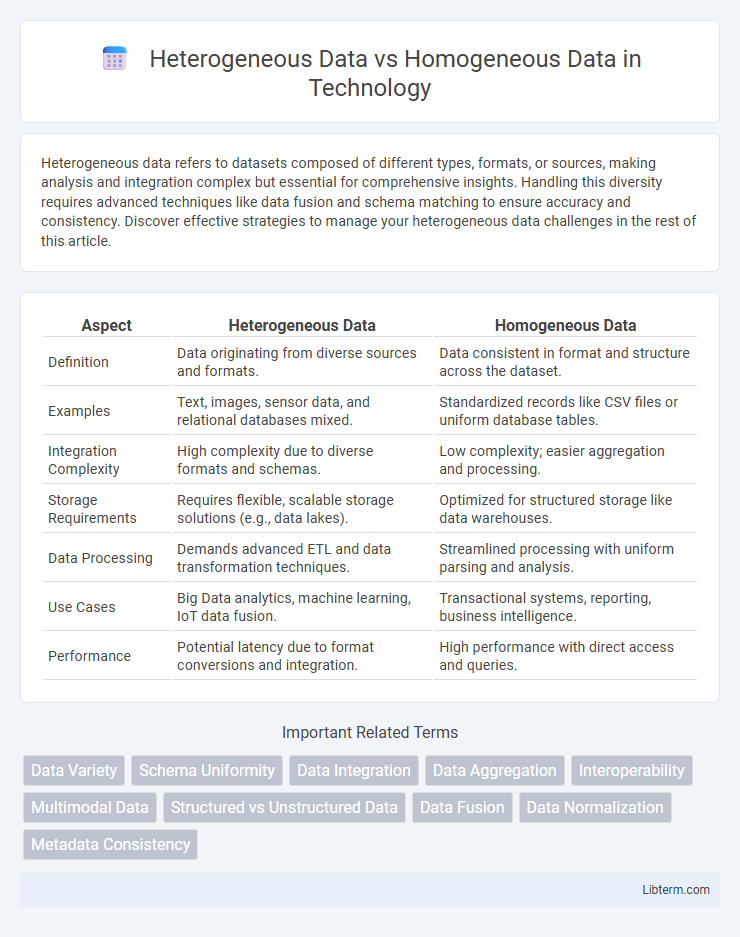Heterogeneous data refers to datasets composed of different types, formats, or sources, making analysis and integration complex but essential for comprehensive insights. Handling this diversity requires advanced techniques like data fusion and schema matching to ensure accuracy and consistency. Discover effective strategies to manage your heterogeneous data challenges in the rest of this article.
Table of Comparison
| Aspect | Heterogeneous Data | Homogeneous Data |
|---|---|---|
| Definition | Data originating from diverse sources and formats. | Data consistent in format and structure across the dataset. |
| Examples | Text, images, sensor data, and relational databases mixed. | Standardized records like CSV files or uniform database tables. |
| Integration Complexity | High complexity due to diverse formats and schemas. | Low complexity; easier aggregation and processing. |
| Storage Requirements | Requires flexible, scalable storage solutions (e.g., data lakes). | Optimized for structured storage like data warehouses. |
| Data Processing | Demands advanced ETL and data transformation techniques. | Streamlined processing with uniform parsing and analysis. |
| Use Cases | Big Data analytics, machine learning, IoT data fusion. | Transactional systems, reporting, business intelligence. |
| Performance | Potential latency due to format conversions and integration. | High performance with direct access and queries. |
Introduction to Heterogeneous and Homogeneous Data
Heterogeneous data refers to datasets composed of different types, formats, or sources, such as combining text, images, and numerical data within a single analysis. Homogeneous data consists of uniform data types, typically structured and consistent in format, like a database table containing only numerical values. Understanding the distinction between heterogeneous and homogeneous data is crucial for effective data integration, processing, and analysis in machine learning and big data environments.
Defining Homogeneous Data
Homogeneous data refers to datasets consisting of elements that share the same data type or structure, ensuring consistency and uniformity across all entries. This uniformity simplifies data processing, storage, and analysis, as the entire dataset adheres to a single format or schema. Common examples include arrays of integers, columns in relational databases with specific data types, and time series data with consistent measurement units.
Defining Heterogeneous Data
Heterogeneous data consists of varied formats, types, and structures originating from multiple sources, such as text, images, videos, and sensor readings. Unlike homogeneous data, which is uniform and consistent in type and structure, heterogeneous data requires advanced integration and processing techniques to enable analysis. Effective management of heterogeneous data supports complex decision-making and comprehensive insights across diverse domains.
Key Differences Between Heterogeneous and Homogeneous Data
Heterogeneous data consists of diverse formats and types, such as structured, unstructured, or semi-structured data, whereas homogeneous data maintains uniform structure and consistent data types throughout. The integration and processing of heterogeneous data require advanced techniques like data normalization and schema mapping, while homogeneous data allows straightforward analysis due to its consistency. Organizations leveraging heterogeneous data benefit from richer insights but face increased complexity compared to simpler management and processing of homogeneous datasets.
Examples of Homogeneous Data in Practice
Homogeneous data refers to datasets consisting of elements with the same type, structure, or format, such as numerical readings from a temperature sensor array or transactional records in a financial database. Examples in practice include time-series data from IoT devices, uniform customer survey responses, and standardized medical test results. These homogeneous datasets enable efficient analysis using statistical techniques and machine learning models due to their consistent nature.
Real-World Applications of Heterogeneous Data
Heterogeneous data, characterized by diverse formats and sources such as text, images, and sensor outputs, drives innovation in sectors like healthcare, finance, and smart cities by enabling comprehensive analysis and richer insights. Real-world applications include predictive maintenance using sensor and operational data, personalized medicine combining genomic and clinical records, and fraud detection through multi-source transaction and behavioral information. This integration of heterogeneous data enhances decision-making accuracy and operational efficiency compared to homogeneous datasets limited to uniform data types.
Advantages and Disadvantages of Homogeneous Data
Homogeneous data, consisting of uniform data types and structures, simplifies data processing and ensures consistency, which enhances accuracy and reduces complexity in analysis. However, this uniformity limits the scope of insights by excluding diverse data sources, potentially overlooking valuable patterns present in heterogeneous data. The lack of variety can impede comprehensive decision-making and restrict adaptability in dynamic environments.
Pros and Cons of Heterogeneous Data
Heterogeneous data encompasses diverse types and formats, enabling comprehensive analysis across multiple sources, which enhances decision-making accuracy and innovation potential. However, it presents challenges such as complexity in integration, increased processing time, and the need for advanced tools to manage and normalize disparate data sets effectively. Despite these obstacles, leveraging heterogeneous data offers a competitive advantage through richer insights compared to homogeneous data, which is uniform but limited in scope.
Choosing the Right Data Type for Your Project
Selecting between heterogeneous data and homogeneous data depends on the project's complexity and data sources. Homogeneous data, consisting of uniform types, simplifies analysis and is ideal for structured datasets such as financial records or sensor readings. Heterogeneous data combines diverse formats like text, images, and numerical values, making it suitable for multifaceted projects requiring comprehensive insights from multiple data types.
Future Trends in Data Diversity and Management
Future trends in data diversity emphasize the growing importance of managing heterogeneous data, integrating structured, unstructured, and semi-structured formats from various sources such as IoT devices, social media, and enterprise databases. Advanced data management frameworks leveraging AI and machine learning enhance the ability to analyze and unify diverse datasets, improving decision-making accuracy and operational efficiency. Innovations in metadata standards and data interoperability protocols drive seamless integration and governance of heterogeneous data, surpassing traditional homogeneous data models focused on uniformity.
Heterogeneous Data Infographic

 libterm.com
libterm.com